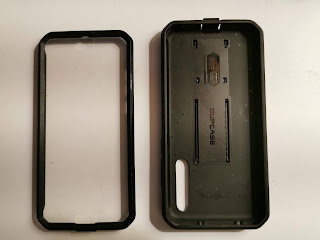I had my Huawei P20 Pro phone for only about a week before I ended up putting it away in my pocket, forgetting I also had a set of keys in there…and that’s how I ended up figuring out that my phone did not come with a pre-installed screen protector. Needless to say, I was panicking, and wanted to figure out an ideal, all-in-one way to protect my screen without blocking the cool “twilight” color scheme on the phone’s back.
Long story short, I discovered that was pretty much impossible. How in the hell hasn’t a company come up with a way to blend a clear back with a built-in screen protector? I mean, when you pay half-a-thousand dollars for a brand new phone, you kind of want to show it off. But after trying in vein for what felt like hours (because it probably was) to find a practical solution, I finally realized that—since it came down to it—I would much rather sacrifice beauty for protection. And that’s why I settled on the Beetle Case from Supcase, which retailed for around $20.

As its weird title alludes to, this is essentially a 360-degree protective shell, consisting of a back piece made of rugged thermoplastic polyurethane, and a front with raised edges to protect against spills, along with a thin layer of clear film that functions as a screen protector, guarding against nicks and slight cuts. It seems to be a pretty practical solution, right? Well I’ve had this setup for over a year, and now it’s time to spill the beans on what kind of long-term support you can expect from this case.
Installation was actually kind of difficult the first time for me, but between the instructions, and taking it apart and putting it back together at least a dozen times since then, I’ve got it down pat. Basically, you put the screen part of the phone on first, which is as simple as snapping it into place, and then you slide the whole thing, bottom first, into the back part of the case. Just be sure to push the sides in to form a solid seal. Once it’s on, everything should work as it normally does: since this is a “custom made” case for this particular phone model, there are cutouts in the screen for the selfie camera, as well as the “home” button. There are also perfectly-placed rubber “buttons” that fit directly over the volume and power buttons off to the side of the phone, which allow for typical functionality. The charger can be accessed by pulling down on a “tab” that fits snug inside when not in use, to prevent dirt and other debris from getting in. It’s a pretty well-designed case overall…well, for the most part.
I’m about 6’1” and have dropped my phone more times than I can count, on a variety of different surfaces, and it’s gotten to the point where I don’t even break a sweat anymore; this thing is built like a tank. If it can take repeated five foot drops onto concrete, chances are it will take anything your clumsy ass can throw at it. Of course, it’s not completely destruction proof: a drop at the wrong angle that connects with only the screen could make short work of the weak plastic “film” protecting the screen, and will more than likely shatter the screen underneath. Deeper cuts can also work their way through the protector, and end up in the actual phone glass. But these are pretty fluky scenarios…as long as you’re not putting knives in the same pocket as your phone, this will have you covered in almost all instances.
While I consider the size and weight of the case to ultimately be a downside (see below), the rubberized grips make handling the phone much easier than it is to hold out of the box. And while the polyurethane backing blocks the phone’s beautiful aesthetic (something I will continue to harp on because it makes me bitter), it does prevent any fingerprints from accumulating on the phone’s (gorgeous) glass back, which has the unfortunate downside of drawing fingerprints like they’re going out of style.

One other “hidden” benefit that I always forget about is the little “kickstand” located on the back of the case, which can be pulled out with a fingernail (or a coin); it gives you the ability to stand the phone up no matter how it’s oriented, making setting up shots on the fly without a tripod (or taking selfies with the rear camera) a breeze. There are certainly a world of pluses to having a case like this on hand.
Aaaah, but there are downsides. There are always downsides.
My biggest pet peeve concerns that all-important screen protector: if your screen gets wet around the “home” key or selfie-cam cutout, water seeps underneath the protective film and gets on the actual glass. Now, this isn’t an urgent matter that’s going to completely destroy your phone—after all, the P20 Pro’s IP rating of IP67 allows for submersion up to 3 metres for up to 30 minutes—but it does lead to performance issues, as anywhere that the water spreads to potentially renders the touchscreen useless. Maybe “useless” is an exaggeration in most cases, but it certainly requires you to press harder to get any sort of reaction, and, depending on the severity of the water seepage, might not even work properly at all.
The fix is pretty simple, and is one of the reasons I’ve gotten adept at taking it apart and re-building it over and over: you have to take apart the case, dry off the protective film and screen, and then put it back on. Again, it’s not hard, but it’s also not practical, especially if you’re at a party or somewhere else in public where you spill a beverage all over yourself and your phone.
The protective film also attracts fingerprints and grime like nobody’s business; it seems like every day my vision is somewhat clouded from some sort of gunk that has somehow accumulated on the screen. Maybe that one’s just me, but I seem to have to spend a few minutes every week wiping it off just to be able to see things clearly. There are also sections along the sides and corners, where the adhesive connects the protective screen to the plastic protection frame, where dead skin just collects, with no way to get to it because it’s stuck in the adhesive. Now, keep in mind this is on the underside of the phone, so no one is going to see it during your normal usage of the phone, but I have to say it’s kind of gross just to know it’s there. Or maybe I’m just gross and don’t wipe enough dead skin off.
Speaking of the film: there are small dots all throughout it, which you can clearly see when you’re applying it. Thankfully, 90% of the time, those go unnoticed in real-world situations, but especially in super-bright days and at the wrong angle, that’s about all you can see. It’s even more annoying considering the P20 Pro already sucks in direct sun glare—I’d imagine this film makes that problem even worse.
As can probably be expected, the thick case also adds quite a bit of weight and depth to the package, which goes counterpoint to the way these phones are often manufactured to be as thin and lightweight as possible. It doesn’t become unwieldy, or anything, but the added weight is definitely noticeable, and doesn’t feel nearly as expensive, or exciting to hold, as the phone on its own.
But the most egregious disadvantage this case has, which I’ve already alluded to numerous times, is that it blocks the gorgeous design of the phone which is meant to stand out in a sea of lame-colored competitors (actually, now many other manufacturers are taking to the “glossy”, “gradient” style designs kickstarted by this series in particular). It’s unfortunate that I either have to choose to “show off” my phone, or protect it, when there should be a variety of ways to do both (that don’t involve re-applying tempered glass every couple of months), but there aren’t and that’s just the way it is.
Overall: 6.5/10. It’s really not an ideal case overall, but as one of the few all-in-one front-and-back phone protection solutions, it does its job, though with a few minor headaches along the way. Its defense against falls is excellent—I’ve dropped this thing probably a hundred times on a variety of surfaces, and it’s gotten to the point where I no longer even bat an eye when it happens, because I know the case will take the brunt of the impact. The included screen protector—while nowhere near as resilient as tempered glass—still does a good job of preventing light nicks and cuts from damaging the actual screen part of your phone. However, there are also pesky annoyances, like the cutouts around the “home” button and camera, which allow water to seep through to the screen when the front gets wet. While these won’t damage the phone itself (it has an IP67 rating, meaning it can be submerged under 3 feet of water for up to 30 minutes), it does cause sensitivity and performance issues to any location where the water has spread, and requires you to either wait for it to dry, work around it, or take it apart to dry it off in order to quickly resume normal operation. It adds bulk and completely covers up the phone’s gorgeous looks, too, which has prevented the phone from getting the attention it so desperately craves. Despite these flaws, though, it has no doubt prevented at least a couple hundred dollars worth of potential damage – a crucial statistic considering Huawei phones are not covered under any sort of warranty in the U.S. – and that more than makes up for at least some of its shortcomings. And for just $20? Well, that’s a pretty solid value any way you look at it.



